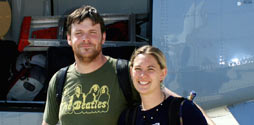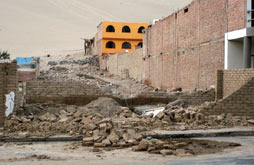By Katie Hudson-Martinez/feature editor

Lying across a bed working a crossword puzzle, Darrell Morehouse and Tara Haelle found no words to express their terror when they were hit by an earthquake in Peru.
The 8.0 magnitude earthquake hit Peru last month, killing at least 510 people and injuring more than 1,600.
Morehouse, a SE campus student, and Haelle, his girlfriend, experienced the death and destruction first hand.
Morehouse and Haelle, an instructor for the Arlington ISD, who is currently teaching a GRE readiness course on South Campus, spent 10 weeks backpacking across South America this summer.
During their adventure, which took them through Bolivia, Argentina, the Galapagos Islands, Ecuador and finally Peru, the pair were confronted with deadly landslides, suspected malaria and a labor force strike where protesters blocked off busy streets with stones.
But their most traumatic experience was the earthquake that hit Peru Aug. 15.
“ We were doing a crossword puzzle when the whole room began to shake violently,” Morehouse said. “For a second, we just looked at each other, dumbfounded and confused.”
The two were on the second floor of their hotel in Huacachina, Peru and Morehouse sought safety by standing in a door frame.
“ It only lasted for two minutes, but two minutes is a long time when the earth is shaking under your feet,” he said.
People were screaming and crying. One fellow tourist was yelling, “Does anyone speak English?”

When the earth stood still again, the two ran outside. It was pitch black. All the electricity had gone out. Water mains were broken, bridges collapsed. Streets were undrivable because of large cracks in the asphalt and debris.
The two joined others outside on the street; after an hour, they went inside to retrieve some of their things.
“ We got our passports, cameras and some flashlights and basically just camped out on the street—it was the middle of the night,” Haelle said.
The two were just closing their eyes to rest when a 6.7 magnitude aftershock a little after midnight brought back their fear.
Things looked worse in the light of day. Food became scarce as almost all of the restaurants had been damaged and had no electricity or water. International calling cards were sold out.
Bus stations were closed and no trains were running. It was difficult to organize a plan because very little information was available about the conditions in surrounding areas.
Finally, after making their way into the town of Ica, the two found a representative of the U.S. Embassy who took them by bus to Pisco, a larger city with an airport.
Pisco was also the hardest hit area—the location of the epicenter.
From the dirty pane windows of the bus, the passengers saw the death and destruction the earthquake had brought.
“ We saw people carrying coffins down the street like pallbearers,” Haelle said. “There were so many dead people; they ran out of coffins.”
The embassy representative took the two Americans to a Peruvian air force base where evacuations of foreign nationals and injured persons were being facilitated.
“We were really impressed by the response of the Peruvian authorities,” Haelle said. “There were ambulances coming in and out constantly, but what we kept hearing is that there were essentially no medical supplies.”

Doctors reported losing patients because of a lack of basic supplies.
“ One doctor told us that he had never had so many people die in his arms in one day. It was heartbreaking,” she said.
Finally, three days after the original earthquake, the two were flown into Lima, where they caught an international flight to the United States.
“ When we finally boarded the plane, we both began crying uncontrollably because we couldn’t believe we were actually getting to go home,” Haelle said.
Almost a month later, the two have settled back into their lives, but they will never forget what happened in Peru.
“ I still haven’t finished that crossword puzzle,” she said with a little laugh. “It just doesn’t seem right.”
